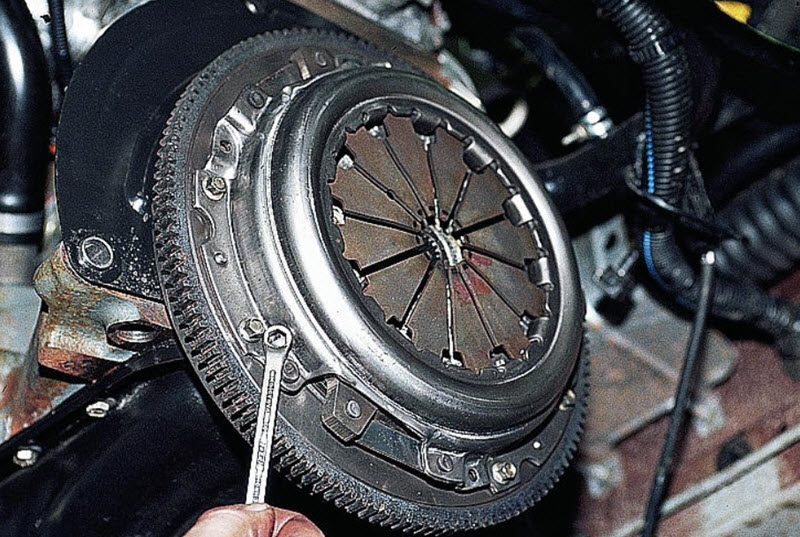
How to understand the condition of the clutch on the mechanics
Content
Cars of wide application with a manual transmission (manual transmission) are becoming less and less in specific ratio, they are being replaced by more convenient automatic transmissions and CVTs. Accordingly, the classic clutch is no longer required, but as long as it is still preserved, mainly in the budget segment and minimum trim levels, you need to know its features and be able to determine the moment of inevitable replacement.

How long does a clutch run in a car
Clutch life is 100% dependent on operating conditions. If you drive on free roads where you don’t have to move off and change gears, then the resource is practically unlimited, the assembly will easily outlive the engine, gearbox and the whole car. In this mode, nothing wears out there, with a small exception that can be neglected.
Maximum wear occurs in urban traffic jams. With each starting off and even when switching, friction of the driven disk occurs on the pressure and surface of the engine flywheel. The release bearing loaded by the force of a powerful spring also wears out.
You can only roughly estimate the strongly averaged mileage before replacement. It ranges from 50 to 150 thousand kilometers. Naturally, a lot depends on other factors:
- vehicle weight;
- engine power;
- the nature of the distribution of torque along the speed curve;
- the design margins for strength and durability, especially the dimensions and area of the friction surface;
- selection of properties of the damper of torsional vibrations;
- clutch quality.
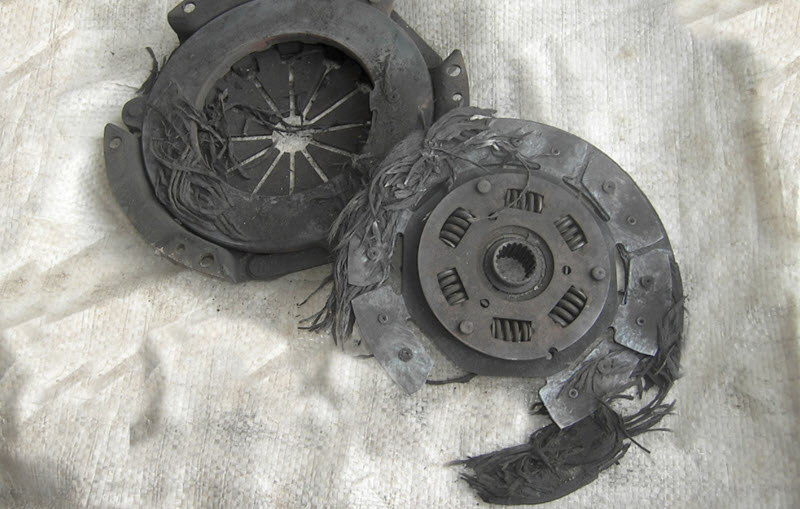
The minimum time that was achieved before the complete destruction of a new high-quality clutch in barbaric experiments is a little more than a minute, and there are cars where it was never changed at all before a major overhaul.
Symptoms of a malfunction
Symptoms of a dying clutch must be known in order to replace it in time. Otherwise, you can destroy other transmission elements, sometimes much more expensive.
Slip
The first and main sign of the beginning of the end is the slipping of the discs with the clutch fully engaged under load. It is often poorly understood by inexperienced drivers.
From the point of view of a person behind the wheel, who does not know the materiel very well, this looks something like a sudden loss of acceleration dynamics. First in higher gears, then in all others. The car seems to be hitting a wall. Many begin to blame the engine and brakes.
It is worth paying attention to the behavior of the tachometer needle, or at least to your own hearing. RPMs go up but speed doesn't.
It’s as if acceleration is on ice, and if you sniff it, then with a not very airtight interior, the smell of burning from the clutch side will be noticeable. Discs skid and instantly overheat. You can’t ride like that, the assembly requires immediate replacement.
Incomplete Disconnect
There are also completely opposite symptoms, although they are often combined. The car pulls forward with the clutch pedal fully depressed. Discs do not disengage.
They say that the clutch "leads". A characteristic feature is that when the car is stationary, it is very difficult to engage first gear with the engine running. It is worth turning off the ignition - and the transmission will easily turn on.
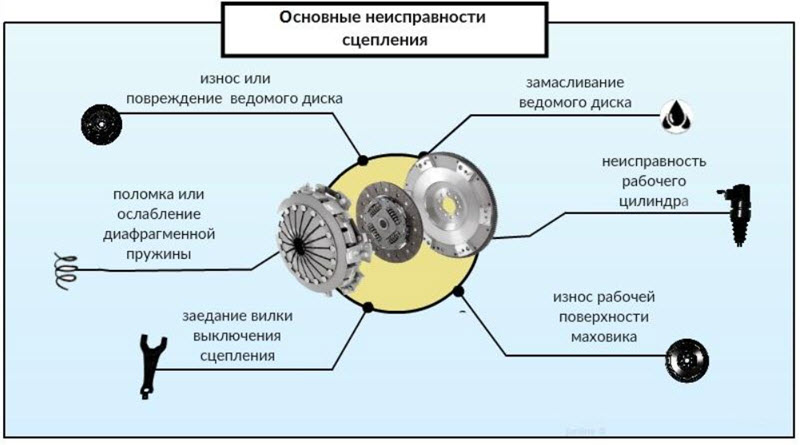

Extraneous noise
Silently in the car rarely something happens. Most often, a worn release bearing begins to howl, whistle and crunch.
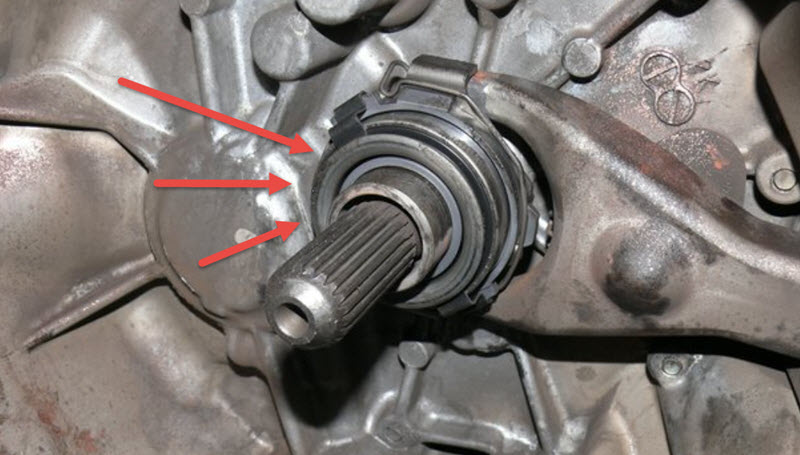

But similar sounds can also be made by a basket with a driven disk, it is enough to bend or break the springs in them. Replaced again, and soon.
Hard pedal
When the clutch has lost its geometric dimensions, or just the release sleeve has become covered with dirt and rust, it is difficult to squeeze such a unit to turn it off.
Do not continue to break the remaining parts or try to lubricate something. Assembly replacement only.
Ways to check
As soon as the above confident signs of critical wear or breakdown appear, further experiments are useless. It is necessary to remove the box and evaluate the condition of the clutch parts.


Watch this video on YouTube
Disk check
There are several reasons for a driven disk to be scrapped:
- the maximum thickness of the friction linings, it is known for each car, and for visual understanding, the disc has recesses in the form of slots, some of which disappear when worn;
- damper springs must be intact and sit tightly in their sockets, a loose damper threatens to break and jam;
- a curved disc will always “drive” the car when squeezed out, and starting off will be accompanied by jerks;
- linings can burn or become oily, which will also cause jerks, vibrations and slip;
- the disc hub may loosen in its mount.
Disk repair is excluded, only replacement. Riveting is long gone.
Cart
The basket will give itself out as a state of the pressure diaphragm spring. Almost always, her petals are deformed, their tips are undermined, or even a part breaks out. Secondary signs in the form of blue disc surface and microcracks appear synchronously with spring defects.
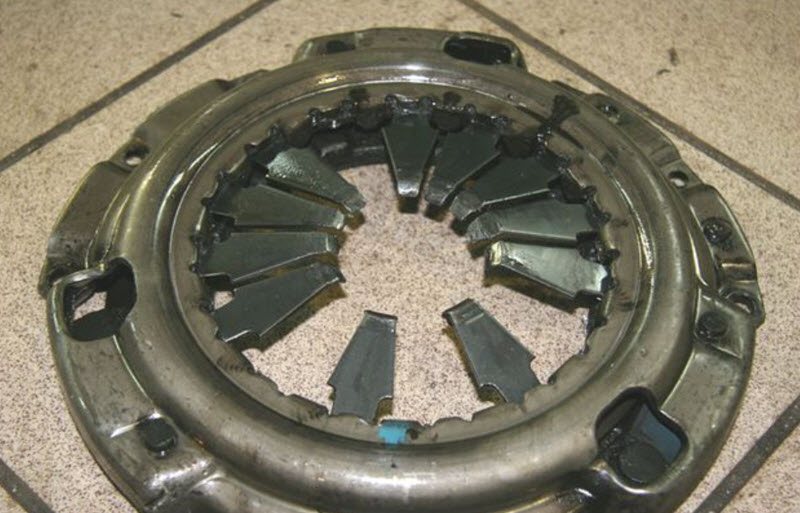

No need to save money by changing only the disk. Only the whole set is assembled, if you do not want to remove the box a couple more times.
Release bearing
Everything is clear with the clutch release, it will either be completely destroyed, or it will hum even when rotated by hand. Unfortunately, the resource of these parts is minimal, by the time the disks wear out, they have long been inoperable and serve with their last strength.
Pedal Free Play Check
Free play on the pedal pad is indicated in the instructions. Its increase is most often associated with drive wear, but may also indicate problems with the release. On older machines, the stroke was regulated, now all clutches are of a backlash-free type with minimal free play.
Checking the Master Cylinder
Leaks in the main cylinder of the hydraulic drive are associated with bypassing its cuff. Fluid usually enters the cabin along the pedal stem, which is immediately noticeable and will force the cylinder assembly to be replaced.


Repair is impractical, although repair kits are sometimes sold. Of the external signs - pedal failures, which can occur randomly, and a decrease in the liquid level in the tank. Pumping rarely helps.
How to test clutch on DSG
DSG is an automatic transmission with two clutches for an even and odd number of gears.
Its work is completely under the control of the electronic unit, which allows the diagnostician with a scanner to get a lot of information on the history of work, the current state of the clutches, and even predict the residual life. All this is monitored by the controller and stored in memory.


Watch this video on YouTube
You can find out the residual thickness of the friction clutches, whether there were dangerous overheating of the discs during operation, the pressure of the mechatronics. To a large extent, the data are indirect, for example, the thickness of the discs is estimated from the adapted stroke.
But the accuracy of the measurements is such that it allows you to estimate the time to replacement, as well as to understand the causes of jerks and other disturbing phenomena. After replacement, if necessary, the new clutch is adapted with the same scanner.